This traditional stone-built pub’s name is a reminder that Yeadon is a former mill town, specialising in the production of woollen cloth. The pub’s been known by this name throughout its long-serving history.
A plaque documenting the history of The Clothiers Arms.
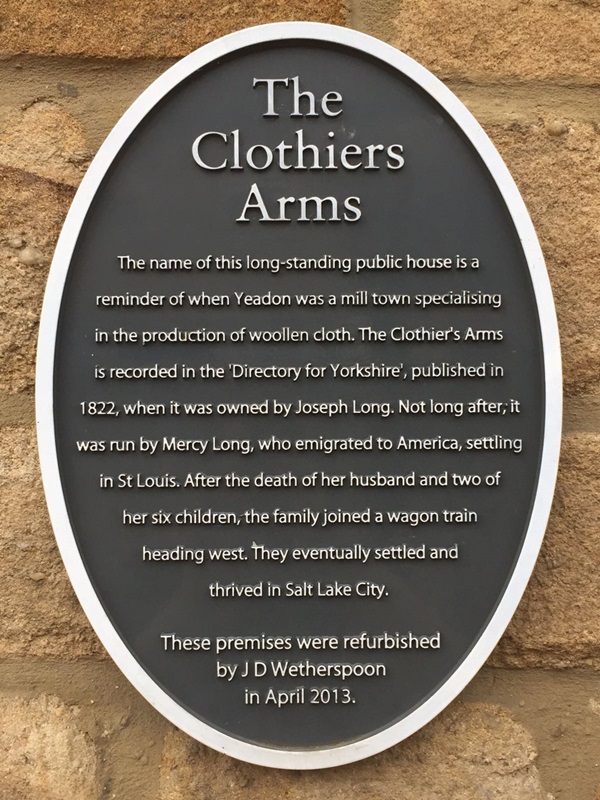
The plaque reads: The name of this long-standing public house is a reminder of when Yeadon was a mill town specialising in the production of woollen cloth. The Clothier’s Arms is recorded in the Directory for Yorkshire, published in 1822, when it was owned by Joseph Long. Not long after, it was run by Mercy Long, who emigrated to America, settling in St Louis. After the death of her husband and two of her six children, the family joined a wagon train heading west. They eventually settled and thrived in Salt Lake City.
These premises were refurbished by J D Wetherspoon in April 2013.
A photograph and text about the history of The Clothier Arms.
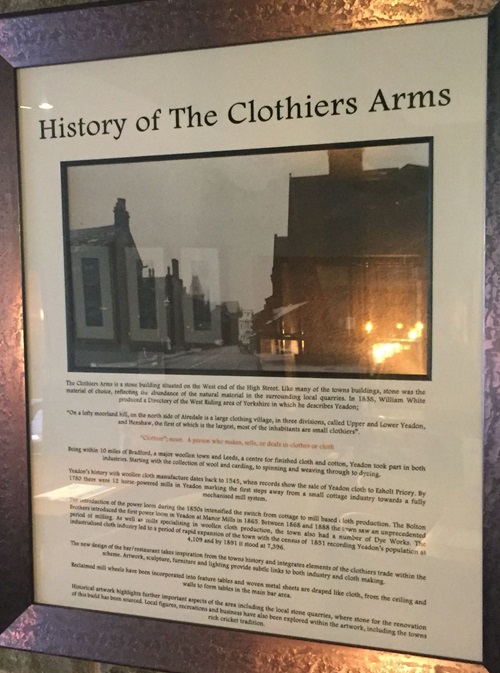
The text reads: The Clothiers Arms is a stone building situated on the west end of the High Street. Like many of the town’s buildings, stone was the material of choice, reflecting the abundance of the natural material in the surrounding local quarries. In 1838, William White produced a Directory of the West Riding area of Yorkshire in which he describes Yeadon;
“On a lofty moorland hill, on the north side of Airedale is a large clothing village, in three divisions, called Upper and Lower Yeadon, and Henshaw, the first of which is the largest, most of the inhabitants are small clothiers.”
“Clothier”; noun. A person who makes, sells, or deals in clothes or cloth.
Within 10 miles of Bradford, a major woollen town and Leeds, a centre for finished cloth and cotton, Yeadon took part in both industries. Starting with the collection of wool and carding, to spinning and weaving through to dyeing.
Yeadon’s history with woollen cloth manufacturer dates back to 1545, when records show the sale of Yeadon cloth to Esholt Priory. By 1780 there were 12 horse-powered mills in Yeadon marking the first steps away from a small cottage industry towards a fully mechanised mill system.
The introduction of the power loom during the 1850s intensified the switch from cottage to mill based cloth production. The Bolton Brothers introduced the first power loom in Yeadon at Manor Mills in 1865. Between 1868 and 1888 the town saw an unprecedented period of milling. As well as mills specialising in woollen cloth production, the town also had a number of Dye Works. The industrialised cloth industry led to a period of rapid expansion of the town with the census of 1851 recording Yeadon’s population at 4,109 and by 1891 it stood at 7,396.
The new design of the bar/restaurant takes inspiration from the town’s history and integrates elements of the clothiers trade within the scheme. Artwork, sculpture, furniture and lighting provide subtle links to both industry and cloth making.
Reclaimed mill wheels have been incorporated into feature tables and woven metal sheets are draped like cloth, from the ceiling and walls to form tables in the main bar area.
Historical artwork highlights further important aspects of the area including the local stone quarries, where stone for the renovation of this build has been sourced. Local figures, recreations and businesses have also been explored within the artwork, including the town’s rich cricket tradition.
Original extracts from According to Hoyle.
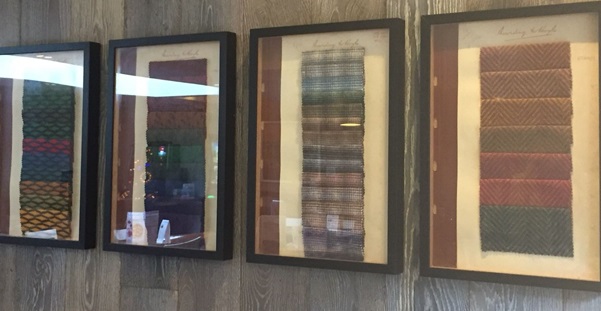
The text reads: This series of original pages were extracted from fabric sample books from the c1950’s collection entitled According to Hoyle. The fabrics were produced by Joseph Hoyle & Son, Prospect Mills, Yorkshire. The first reference of Hoyle’s manufacturing cloth at Prospect mills was in the Kellys Directory of West Riding of Yorkshire dated 1867.
A photograph of the interior of Hillside Mill, Yorkshire, 1953.
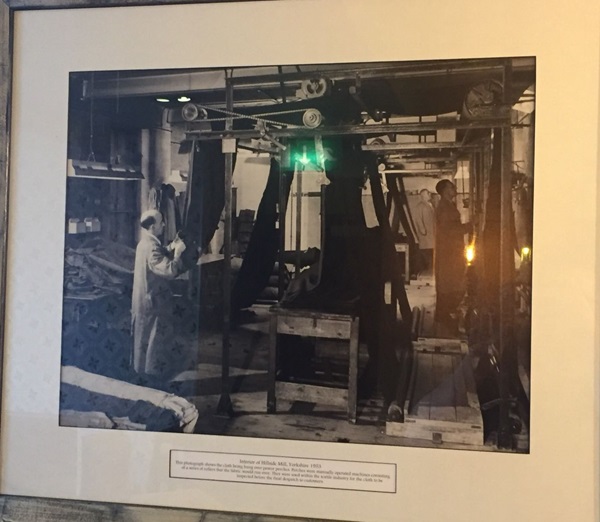
This photograph shows the cloth being hung over power perches. Perches were manually operated machines consisting of a series of rollers that the fabric would run over. They were used within the textile industry for the cloth to be inspected before the final despatch to customers.
A photograph and text about William Flesher & Sons.
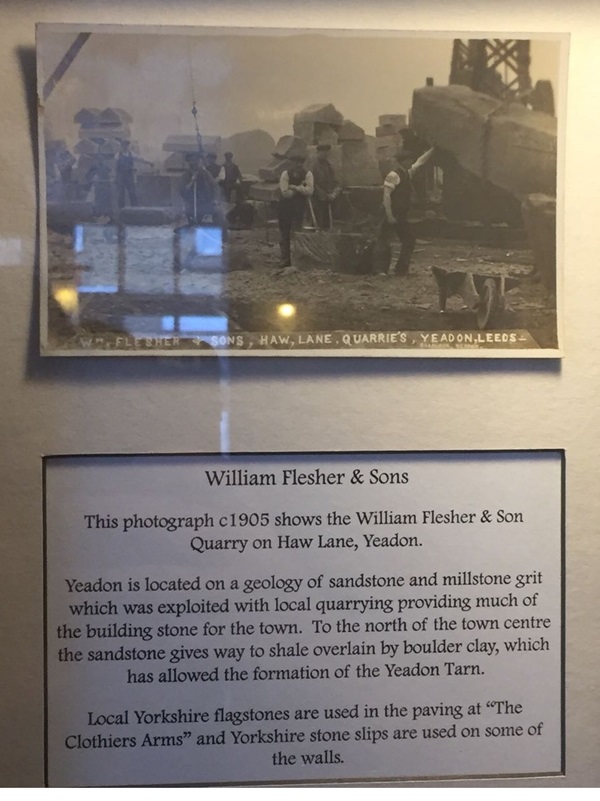
Yeadon is located on a geology of sandstone and millstone grit which was exploited with local quarrying providing much of the building stone for the town. To the north of the town centre the sandstone gives way to shale overlain by boulder clay, which has allowed the formation of the Yeadon Tarn.
Local Yorkshire flagstones are used in the paving at The Clothier Arms and Yorkshire stone slips are used in some of the walls.
A photograph and text about the Yorkshire Eleven in 1885.
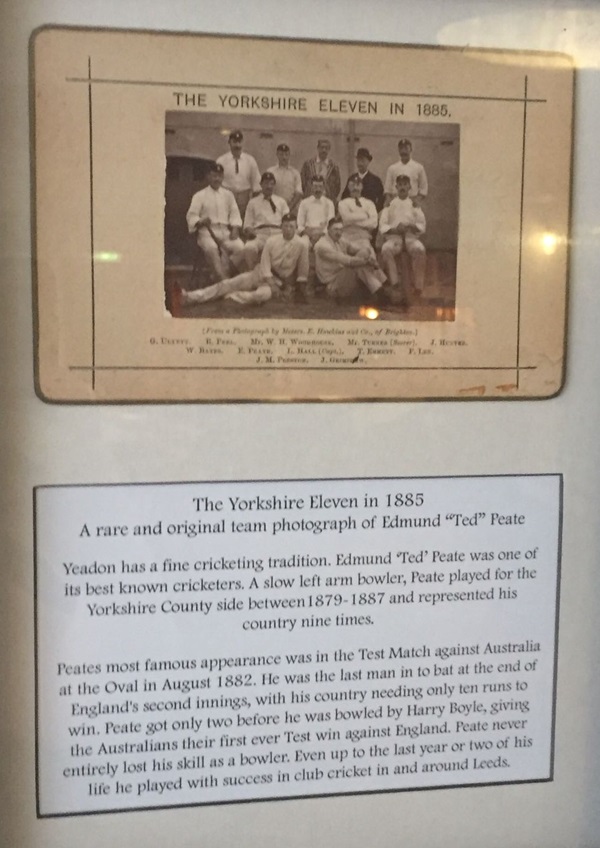
The text reads: Yeadon has a fine cricketing tradition. Edmund ‘Ted’ Peate was one of its best known cricketers. A slow left arm bowler, Peate played for the Yorkshire Country side between 1879-1887 and represented his country nine times.
Peate’s most famous appearance was in the Test Match against Australia at the Oval in August 1882. He was the last man in to bat at the end of England’s second innings, with his country needing only ten runs to win. Peate got only two before he was bowled by Harry Boyle, giving the Australians their first ever Test win against England. Peate never entirely lost his skill as a bowler. Even up to the last year or two of his life he played with success in club cricket in and around Leeds.
A photograph of the Yorkshire Eleven, 1885.
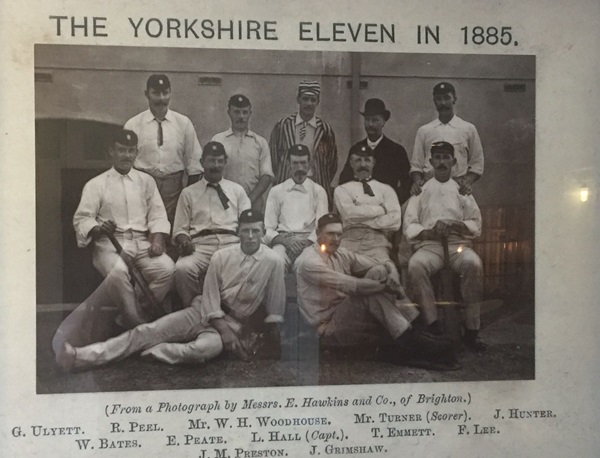
A sculpture entitled Transverse Thread, by Robert Lewis.
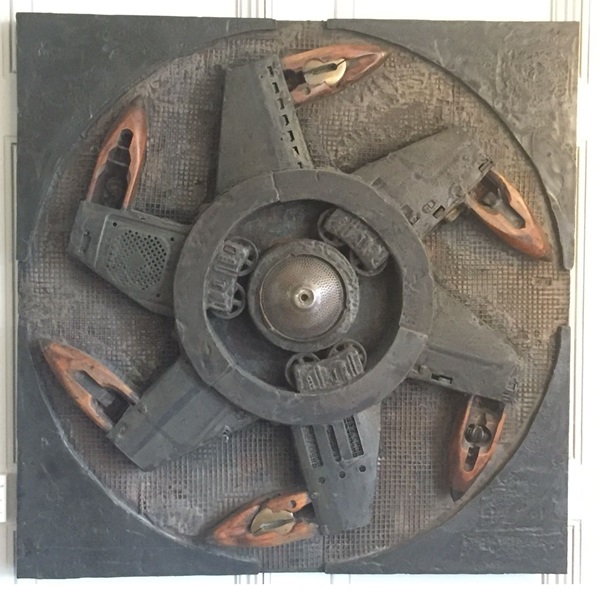
This sculpture was commissioned by J D Wetherspoon from local artist Robert Lewis.
Robert initially trained in engineering before studying Fine Art. “Generally, my work is an investigated into the relationship between the human condition and the technological landscape. This piece combines nature with the lasting legacy of an industry that had the power to quickly and irreversibly effect that technological landscape.”
A sculpture entitled Warp and Weft, by Jacquie Yeates.
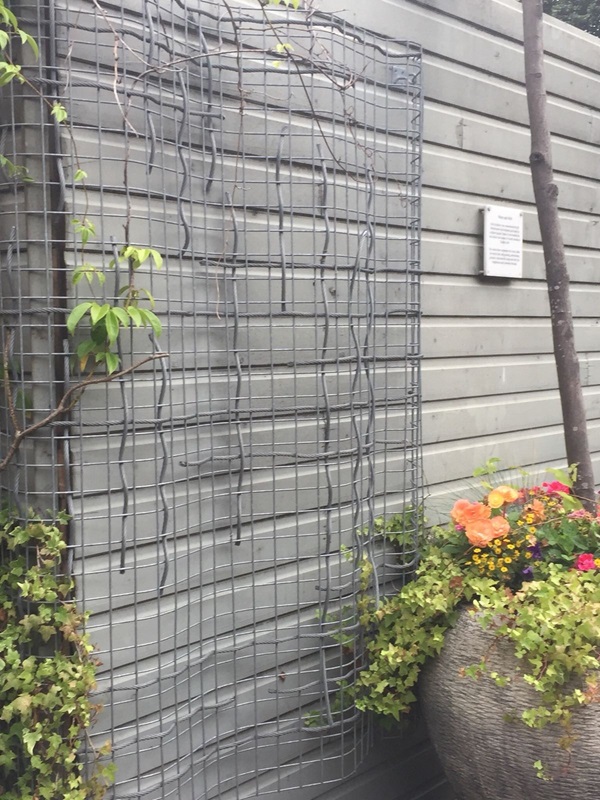
This sculpture was commissioned by J D Wetherspoon and designed and made by sculpture Jacquie Yeates. It was inspired by the texture and weaves of locally produced Yeadon cloth.
The main frame represents the loom, while the metal rope and growing, intertwining greenery represent the warp and west, the lengthways and crossways threads.
A woollen cloth montage.
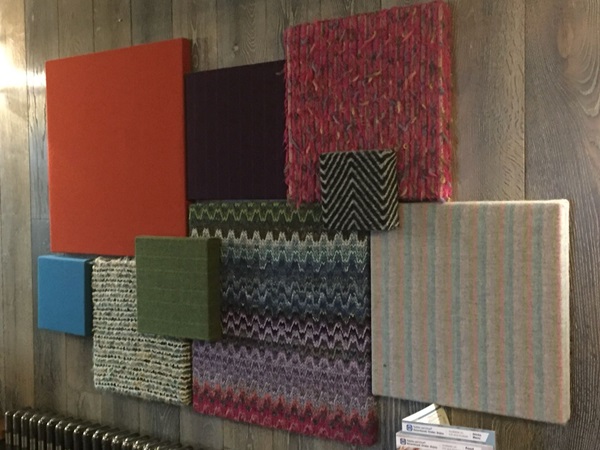
Yeadon is situated between the River Aire and the River Wharfe. The town developed with the woollen industry, firstly as a cottage industry in which the clothiers worked small looms in their houses, to a mill town in the 1860s when the first power looms were installed at the Manor Mills. However the cottage industry had all but disappeared by the 1880’s when only a few hand-loom weavers were left producing high quality cloth. Yeadon grew quickly as a mill town with five mills opening between 1868 and1877.
Albert Mill was one of the largest mills in Yeadon built in 1851 by Baldwin, Brown & Co, this mill was used during World War II as a military store. Moorfield Mill built in 1877 by William Murgatroyd, who was known locally in Yeadon as ‘Billy Murg’. Westfield Mill, built in 1888 by Edward Denison, was one of the woollen mills that was served by the Yeadon branch railway line.
During the 19th century Yeadon was a place ‘mostly of clothiers’ who were engaged in more than 40 different aspects of the production of woollen cloth. This display represents some of the many types of woollen cloth that were produced in Yeadon.
Prints entitled A Sheep’s Life!
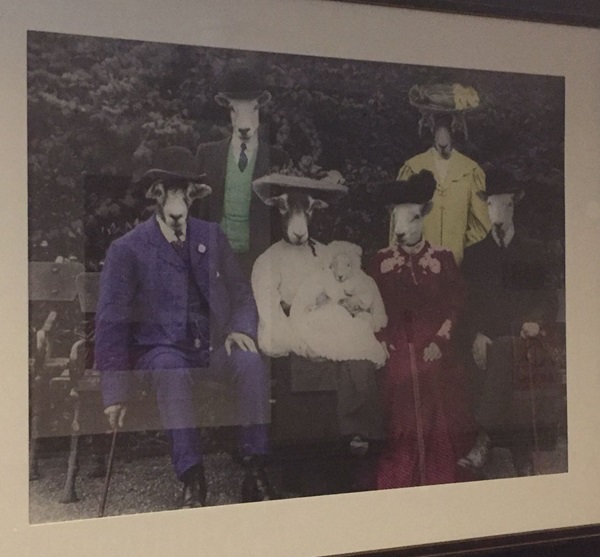
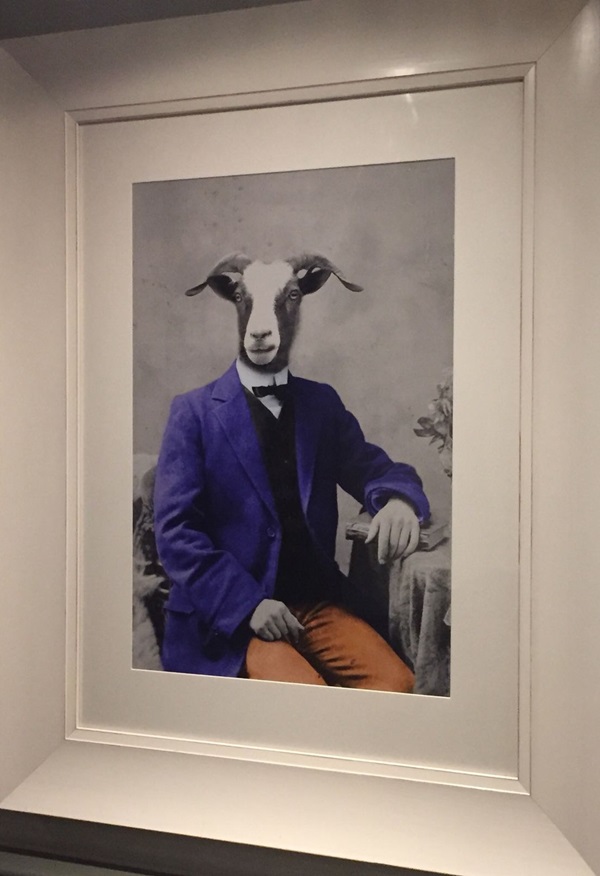
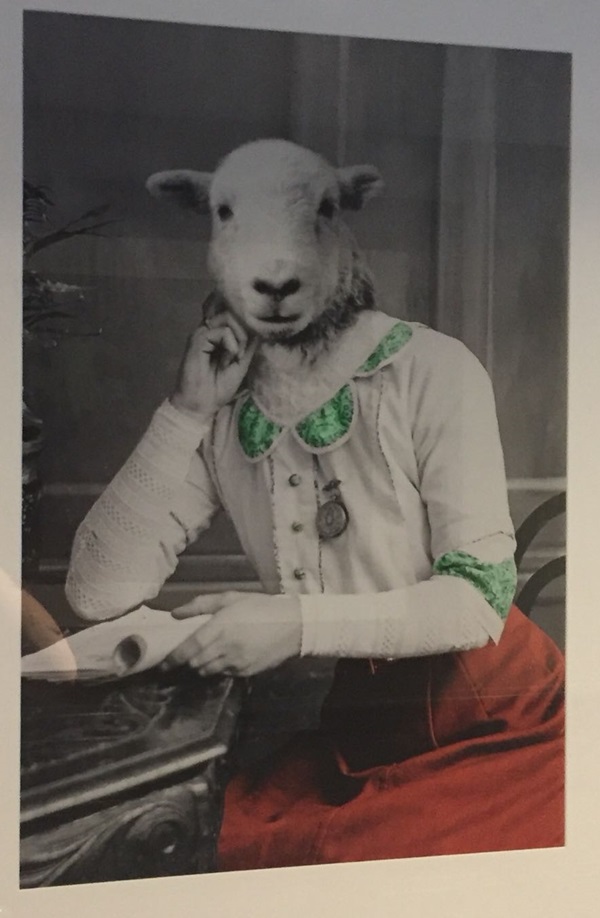
This collection of artworks is a play on Yeadon’s historic connection to the wool trade and its cloth making industry.
The National Gazette of 1868 mentions Yeadon residents as being ‘chiefly employed in the woollen manufactured, which is extensively carried out by both larger companies and private individuals’.
Various breeds of sheep are raised for their unique wool qualities as suited to particular garments and manufacturers. Once removed, the fleece wool is graded by coarseness and separated out for specialized methods of processing and different end products.
The wool in the outer layer of a fleece is longer, thicker and coarser than the wool from the inner layers. These fibres would be spun into ‘worsted’ yarn used for clothing, like suits. The inner layers of fleece had softer wool of varying lengths that would be spun into ‘woollen’ yarn that was used for heavy clothing and blankets.
External photograph of the building – main entrance.
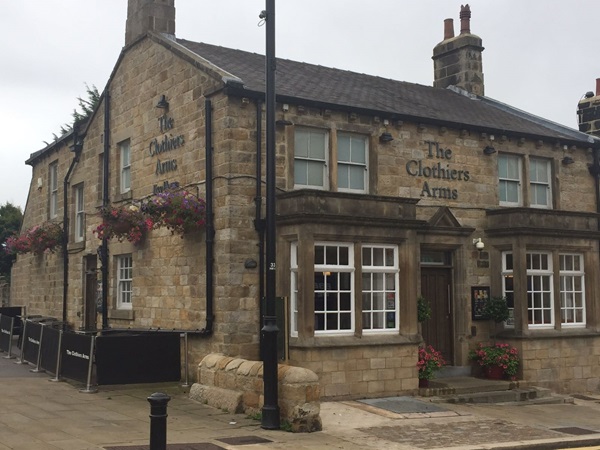
If you have information on the history of this pub, then we’d like you to share it with us. Please e-mail all information to: pubhistories@jdwetherspoon.co.uk